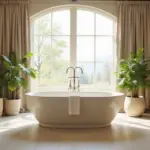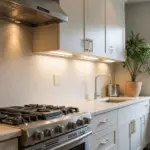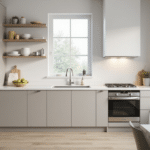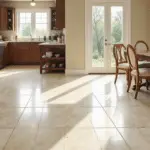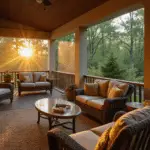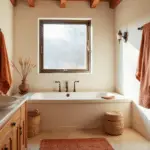Ever walked into a living room that instantly felt right? Or one that seemed off despite beautiful furniture? Often, the secret lies in those fabric panels framing the windows. Living room curtains aren’t just fabric hanging around—they’re powerful design elements that control light, enhance privacy, add warmth, and inject personality.
With endless fabrics, colors, patterns, and styles available, finding the perfect curtains can feel overwhelming. But don’t worry—I’ve compiled 20 essential tips to guide you through the selection process. Let’s transform your space from merely functional to absolutely captivating.
1. Block Out the World: Why Blackout Curtains are a Living Room Must-Have
Blackout curtains offer far more benefits than just blocking light. Their dense, opaque lining eliminates sunlight for daytime napping, creates the perfect movie-watching environment by banishing screen glare, and enhances privacy. They’re also excellent insulators, regulating room temperature and potentially reducing energy costs. Plus, they protect valuable furniture from sun damage and minimize outside noise—creating a truly tranquil living space.

While they’re essential for shift workers, blackout curtains benefit everyone. They’re perfect for weekend movie marathons without battling glare or enjoying a cool, shaded living room on hot summer days. Their multi-layered construction with specialized coating is what makes them significantly more effective at light blocking than standard curtains.
Here’s the catch—blackout curtains aren’t just practical; they can be beautiful too. Choose them in bold colors or patterns to make a design statement while enjoying their functional benefits.
2. Let the Light In: The Airy Charm of Sheer Curtains for Your Living Room
Sheer curtains bring a completely different vibe to your space. Their magic lies in transforming harsh sunlight into a gentle, diffused glow that bathes your living room in warmth. They create that bright, airy feeling while providing daytime privacy without sacrificing your view. The lightweight, flowing nature of sheers adds movement and visual interest—introducing an element of understated elegance.

The world of sheer fabrics offers delightful variety. Voile is budget-friendly and semi-transparent with a delicate feel. Chiffon is even finer, lending a formal, luxurious touch. Linen sheers add textured sophistication with an organic appeal, while lace sheers bring intricate patterns for vintage or bohemian aesthetics. For color, white or off-white sheers are timeless and versatile, while pastels add subtle color without overwhelming the space.
“Sheer curtains are like the perfect Instagram filter for your living room—they soften everything they touch and make even ordinary light look extraordinary.”
The beautiful thing about sheers is how they transform throughout the day, shifting with the changing light. Now let’s explore something with more substance and luxury—velvet curtains.
3. Velvet Dreams: Adding Luxurious Texture with Velvet Living Room Curtains
Velvet curtains instantly elevate any living room with a dose of luxury few other fabrics can match. Their dense weave effectively blocks light, creating a cozy retreat perfect for relaxation. This same quality provides excellent insulation, helping regulate room temperature and potentially reducing energy costs. But velvet’s true magic lies in its texture—that plush, soft pile with inherent sheen creates a visually captivating experience. The way velvet drapes adds a sense of grandeur to any window.

When selecting velvet curtains, consider their weight—heavier velvet offers superior insulation but requires stronger curtain rods. Color choice is crucial in maximizing impact. Deep emerald green, rich blue, or burgundy create dramatic, opulent atmospheres. Lighter shades like blush pink or muted grey offer a softer, more contemporary take. Remember that velvet attracts dust and may need professional cleaning to maintain its luster. Despite these considerations, velvet works surprisingly well in both traditional and modern settings.
- Pair velvet with sheer panels for balanced light control
- Choose colors that complement your existing color scheme
- Consider the room’s natural light—darker velvets absorb more light
- Look for quality construction with proper lining
What if you prefer something with more natural texture and casual elegance? Let’s shift our focus to linen curtains.
4. Linen Love: Embrace Natural Elegance with Linen Curtains in Your Living Room
Linen curtains bring a breath of fresh air into any living room with their natural beauty and relaxed sophistication. Their inherent organic charm creates a calming, inviting atmosphere while their subtle texture adds visual interest without overwhelming the space. Linen gently filters natural light, brightening your room while still providing privacy. It drapes beautifully, creating elegant folds that enhance your windows. As a bonus, linen is both durable and sustainable—an eco-friendly option that ensures long-lasting beauty.

These versatile curtains complement a wide range of living room styles. They’re particularly at home in bohemian, coastal, Scandinavian, and farmhouse-inspired interiors. But linen’s adaptability extends beyond these specific styles. With the right color and hardware, linen curtains integrate seamlessly into traditional or modern settings. Crisp white linen feels modern, while natural, undyed linen lends itself to rustic or bohemian styles. For light filtration, expect a semi-sheer level that strikes a perfect balance—allowing significant natural light while gently diffusing harsh sunlight.
Think of linen as nature’s gift to your windows—it gets softer and more beautiful with time, just like a well-loved home. But what if you’re looking to make a bolder statement? Let’s explore how patterned curtains can transform your space.
5. Go Bold or Go Home: Making a Statement with Patterned Living Room Curtains
Patterned curtains inject personality and visual dynamism into your living room. They’re perfect when you want to create a focal point, add visual interest, or breathe life into a neutral space. Consider them when your existing décor is primarily solid-colored and you want to add vibrant pops without repainting. They’re also ideal for tying together disparate elements or adding depth to rooms lacking architectural details.

The pattern world offers something for every taste. Geometric patterns bring contemporary edge with modern shapes and abstract designs. Florals range from delicate botanicals to bold tropical prints. Stripes can visually heighten or widen a room. Damask patterns offer traditional elegance, while toile depicts charming pastoral scenes. Abstract patterns bring artistic flair, and ikat features intricate, blurred designs with bohemian vibes.
When choosing patterns, consider scale in relation to room size—smaller rooms benefit from smaller-scale patterns, while larger rooms can handle bold, larger patterns. Ensure colors incorporate hues already present in your room, and avoid choosing patterns that clash with existing patterns to prevent visual chaos.
The right pattern can become the heart of your living room’s personality, telling your design story at a glance. But if patterns feel too bold, let’s consider the timeless appeal of solid colors.
6. Solid Colors, Solid Style: The Timeless Appeal of Solid Color Living Room Curtains
Solid color curtains offer understated elegance and adaptability that make them consistently stylish across various design styles. Their simplicity creates a clean, uncluttered aesthetic that seamlessly integrates into everything from minimalist to bohemian interiors. They can act as a neutral backdrop, allowing other décor elements to shine, or serve as a subtle accent. Unlike patterns that may become dated, solid colors possess a timeless quality, remaining consistently stylish and adaptable over time.

Selecting the right solid color is key to enhancing your living room’s ambiance. Consider your existing color palette—for a calming look, choose a color that complements your wall color. Alternatively, select a color that picks up subtle tones from your furniture and accessories. For a bolder statement, opt for a contrasting color that adds visual interest and depth. Factor in natural light—darker shades create cozier, intimate feels in bright rooms, while lighter shades brighten darker spaces. Warm colors inject energy, while cool colors promote relaxation.
- For drama: Choose a color slightly darker than your walls
- For cohesion: Select a shade from your existing palette
- For contrast: Pick a complementary color from the color wheel
- For texture: Consider fabrics with subtle weaves or finishes
Now that we’ve explored color, let’s consider how curtain length dramatically impacts your living room’s look and feel.
7. Floor-to-Ceiling Drama: Creating Height and Elegance with Long Living Room Curtains
Floor-to-ceiling curtains are a design secret weapon for instantly elevating your living room’s perceived height and elegance. By drawing the eye upward, they create the illusion of higher ceilings, making your space feel more spacious and grand. This vertical emphasis adds sophistication, transforming ordinary windows into striking architectural features. Beyond aesthetics, these curtains provide superior light control and insulation, minimizing light gaps and enhancing energy efficiency.

The perfect floor-to-ceiling look hinges on length. Ideally, these curtains should either just “kiss” the floor for a clean, tailored look, or “puddle” slightly for added drama. Kissing the floor creates a modern aesthetic that’s practical and easy to maintain. Puddling adds luxury and romance but requires more maintenance as excess fabric collects dust. Fabric choice matters too—lighter fabrics like linen create breezy, airy feels, while heavier options like velvet add opulence and better insulation.
The drama of floor-length curtains transforms ordinary windows into statement features—but what if you want to take that luxurious look even further? Let’s explore the intentionally relaxed and chic look of puddled curtains.
8. Perfectly Puddled: The Chic and Relaxed Look of Puddled Curtains
Puddled curtains feature intentional excess length that creates a “puddle” of fabric spilling onto the floor. This deliberate design choice achieves a relaxed, romantic, and slightly bohemian aesthetic, exuding effortless chic. The soft folds and flowing fabric create a sense of movement and visual interest, adding a touch of whimsy and informality to your living room.

These curtains work best in spaces where a formal or highly structured appearance isn’t the goal. They beautifully complement Bohemian, Shabby Chic, Romantic, and Traditional (with a relaxed twist) styles. They’re well-suited for living rooms where a softer, lived-in feel is desired. The success of puddled curtains depends on fabrics that drape beautifully—linen offers natural drape and relaxed elegance, velvet adds opulence, silk creates sophisticated romance, and heavy cotton provides a more substantial puddle with casual feel.
For puddle size, a subtle effect might only require 2-3 extra inches beyond floor-length, while dramatic puddles can extend 6-12 inches or more. Consider your room size when determining puddle depth—larger rooms handle more substantial puddles without feeling overwhelmed.
The romantic appeal of puddled curtains brings softness to your space, but if you prefer something with cleaner lines, let’s explore grommet top curtains next.
9. Crisp and Clean: The Modern Look of Grommet Top Living Room Curtains
Grommet top curtains feature metal or plastic rings evenly spaced along the top edge, with the curtain rod threaded directly through these grommets. This creates clean, uniform folds that cascade down in a distinctly modern, streamlined look. The construction facilitates smooth operation—curtains glide effortlessly along the rod, making them incredibly easy to open and close.

These curtains offer several advantages for contemporary living rooms. Their clean lines and uniform folds instantly lend a minimalist feel that complements modern décor. They’re remarkably easy to install—simply thread the rod through the grommets and hang. The grommets ensure consistent folds, creating a polished look with minimal effort. They also tend to hang straighter than other styles, maintaining their crisp appearance. There are a few minor drawbacks—they can be slightly more expensive due to the added hardware, may allow minimal light leakage through the grommet area, and require a complementary curtain rod since it remains visible.
The modern appeal of grommet tops brings contemporary flair to your windows, but if you’re looking for something with classic versatility, let’s turn to pleated curtains.
10. Classic and Versatile: The Enduring Appeal of Pleated Living Room Curtains
Pleated curtains offer an array of styles distinguished by the type of pleat at the top. Pinch pleats (or French pleats) create elegant, structured folds for a tailored, sophisticated appearance. Pencil pleats provide a softer, more casual look with a gently undulating top edge. Goblet pleats feature a rounded, goblet-like shape for a luxurious touch. Box pleats create clean, tailored looks with flat, folded pleats forming distinct box shapes. Cartridge pleats feature single, deep pleats creating rounded, cylindrical shapes for architectural interest. Inverted pleats fold to the back for a clean, flat front.

These curtains are celebrated for their versatility, adapting to various styles and functional needs. They complement diverse interior designs from traditional to minimalist, depending on the pleat type, fabric, and hardware. They work beautifully with various fabric weights and textures, from lightweight linens to heavy velvets. They’re compatible with different hardware types and offer effective light control ranging from sheer fabrics for diffused light to blackout linings for complete darkness.
“Pleated curtains are like the classic white shirt of window treatments—they never go out of style and can be dressed up or down to suit any occasion.”
Now that we’ve explored various curtain styles, let’s dive into the world of color palettes that go beyond basic beige.
11. Beyond Basic Beige: Exploring Color Palettes for Living Room Curtains
Choosing curtain colors that enhance your living room without being predictable involves thoughtful consideration of color theory. Start by identifying dominant colors in your space—wall color, furniture upholstery, and flooring tones. Then use the color wheel as your guide. Complementary colors (opposite on the wheel) create vibrant contrast and energy. Analogous colors (adjacent on the wheel) offer harmonious, subtle looks. Pay attention to undertones—warm or cool—and choose curtains with similar undertones for cohesive feels.

Natural light dramatically influences how colors appear. In bright rooms, you have greater flexibility—darker colors feel luxurious without gloominess, while lighter colors appear even brighter. In spaces with limited natural light, avoid dark or overly muted colors that can make the room feel smaller and gloomier. Instead, opt for light, bright colors to maximize available light. For patterned curtains, vary the scale of patterns to avoid clashing with existing patterns. Ensure the curtain pattern shares at least one common color with other patterns or solids in the room, creating a visual link for cohesion.
The right color choice transforms your living room curtains from mere window coverings to design statements. Let’s now explore how to match your curtains to your overall décor for a harmonious design.
12. Matching Your Curtains to Your Decor: A Guide to Harmonious Living Room Design
Matching curtains to your overall living room décor creates a cohesive, visually appealing space. Well-matched curtains seamlessly integrate with furniture, wall color, rugs, and accessories, establishing harmony and preventing them from appearing as afterthoughts. A harmoniously decorated room feels more polished, refined, and inviting, enhancing overall comfort and enjoyment.

When choosing curtain colors to complement existing décor, consider your color scheme approach. For monochromatic looks, select curtains in lighter or darker shades of your wall color. For complementary schemes, introduce contrasting colors like blue and orange for exciting visual interest. For analogous schemes, use colors adjacent on the color wheel for subtle harmony. In neutral living rooms, curtains become powerful tools for injecting personality and vibrancy. Choose a bold color or pattern that complements existing neutral tones while creating a focal point. Echo this accent color in throw pillows, artwork, or decorative accessories to tie the space together.
Fabric choice significantly impacts both aesthetics and function. Heavier fabrics add opulence and formality while providing excellent light control and insulation. Lighter fabrics create relaxed, breezy atmospheres and allow natural light filtration. Textured fabrics add depth and visual interest, while smooth fabrics offer streamlined, modern looks.
The perfect curtain-décor match creates a living room that feels intentionally designed rather than randomly assembled. Now, let’s explore how layering curtains can add even more depth and dimension.
13. Layering Curtains for Depth and Dimension: A Pro Decorator’s Secret
Layering curtains offers benefits extending far beyond aesthetics. This technique provides unparalleled light control, allowing transition from sheer diffusion during the day to complete blackout at night. It enhances insulation, creating more effective barriers against heat and cold to regulate room temperature and potentially reduce energy costs. Visually, layering introduces depth and texture through the interplay of different fabrics, colors, and textures, making rooms feel more luxurious and thoughtfully designed.

Popular layering combinations offer diverse possibilities. Pairing sheer curtains with blackout curtains provides daytime privacy and soft light diffusion, plus nighttime privacy and complete light blockage. Combining different fabric weights, like linen and velvet, creates rich textural contrast. Layering varying lengths adds dramatic visual interest, while mixing patterns with solid colors creates focal points without overwhelming the space.
The beauty of layered curtains lies in their adaptability—they can be adjusted throughout the day to suit changing light conditions and privacy needs. Speaking of adaptability, let’s explore how insulated curtains can enhance comfort while saving money.
14. Thermal Comfort: How Insulated Curtains Can Save You Money and Enhance Your Living Room
Insulated curtains act as thermal barriers, regulating temperature and improving energy efficiency. Their multi-layered construction minimizes heat transfer between your living room and the outside. In winter, these layers trap heat inside, preventing escape through windows and reducing heating needs. In summer, they reflect sunlight and block heat, keeping rooms cooler and decreasing air conditioning reliance.

Several types of insulated curtains are available, each with different insulation levels and price points. Thermal lined curtains offer good balance between insulation and cost-effectiveness. Blackout curtains provide decent thermal insulation as a byproduct of their light-blocking design. Multi-layered curtains maximize thermal protection but often cost more. Foam-backed curtains significantly increase insulation while also dampening sound. The best choice depends on your climate, sunlight exposure, desired insulation level, and budget.
- Potential energy savings: Up to 25% reduction in energy loss through windows
- Best for cold climates: Multi-layered or foam-backed curtains
- Best for hot, sunny rooms: Reflective-backed thermal curtains
- Budget-friendly option: Thermal-lined or blackout curtains
Insulated curtains prove that practical features can also be stylish. For those who enjoy hands-on projects, let’s explore DIY curtain rod options next.
15. DIY Curtain Rods: Creative and Budget-Friendly Hanging Solutions
DIY curtain rods offer compelling alternatives to store-bought options. They’re incredibly budget-friendly, often costing significantly less than commercial rods, especially for custom sizes or unique styles. They provide complete customization to perfectly fit specific window dimensions and desired aesthetics—particularly valuable for unusual windows where standard rods won’t work. DIY rods inject unique, personalized touches that reflect your creativity and resourcefulness. Plus, they’re often constructed from readily available or repurposed materials, promoting sustainability.

The possibilities for materials are surprisingly diverse. Plumbing pipes (galvanized steel or copper) offer industrial looks and robust support for heavy curtains. PVC pipes provide lighter, more affordable alternatives that can be painted to match décor. Wooden dowels can be painted, stained, or varnished to match any style. Tree branches add rustic, organic touches when properly dried and treated. Thick rope or twine creates bohemian or nautical vibes. Bamboo poles offer lightweight, eco-friendly options with natural texture. Metal tubing provides sleek, modern aesthetics ideal for minimalist spaces.
These creative solutions allow you to customize your window treatments while expressing your personal style. But once you’ve hung your perfect curtains, how do you keep them looking their best? Let’s explore cleaning and care next.
16. Cleaning and Caring for Your Living Room Curtains: Keep Them Looking Fresh
The ideal cleaning frequency for living room curtains depends on fabric type, environmental conditions, and household habits. Generally, aim to clean curtains every 3-6 months to remove accumulated dust, allergens, and odors. Curtains in high-traffic areas or homes with pets, children, or smokers may need cleaning every 2-3 months. Monthly vacuuming with an upholstery attachment helps remove surface dust between deeper cleanings.

Different fabrics require different cleaning approaches. Always check the manufacturer’s care label first. Delicate fabrics like silk, linen, and velvet often need professional dry cleaning. Polyester and cotton blends can typically be machine washed on gentle cycles with cold water and mild detergent. Sheer curtains should be handled carefully, perhaps placed in mesh laundry bags during washing. Blackout curtains with special coatings may be sensitive to washing—vacuuming and spot cleaning are often safest.
For maintenance between deep cleanings, regular vacuuming removes dust and allergens. Prompt spot cleaning addresses spills before they set. Opening windows periodically airs out curtains and prevents odor buildup. Rotating between different curtain sets distributes wear more evenly. Before machine washing, remove all hardware, use cold water and gentle cycles, avoid overloading the machine, and test for colorfastness.
Proper care ensures your curtains remain beautiful for years, but what if you’re working with a limited budget? Let’s explore affordable options next.
17. Budget-Friendly Curtain Finds: Stylish Living Room Curtains Without Breaking the Bank
Finding stylish living room curtains without exceeding your budget is entirely achievable with strategic shopping. Online retailers like Amazon, Overstock, and Wayfair offer extensive selections at competitive prices with frequent sales. Discount department stores and home goods chains like Target, Walmart, and HomeGoods carry surprisingly stylish options at lower prices than specialized stores. Don’t overlook thrift stores, consignment shops, and online marketplaces for unique finds at bargain prices. Local fabric stores can be cost-effective for DIY enthusiasts, especially when exploring remnants or clearance sections.

Certain materials are more affordable than premium natural fibers. Polyester and polyester blends are generally the most budget-friendly, mass-produced and available in various styles, colors, and patterns. Microfiber is another affordable synthetic option—soft, lightweight, and easy to care for. Modern synthetic fabrics have improved significantly, effectively mimicking more expensive materials while remaining budget-friendly.
To make inexpensive curtains look more luxurious, upgrade the hardware—replace basic rods with more stylish ones in finishes like brushed nickel or matte black. Add decorative tiebacks or tassels for elegance. Hem curtains to the correct length for a tailored appearance. Use curtain rings or clips instead of rod pockets for more defined folds. Steam or iron curtains before hanging to remove wrinkles and create a crisp, polished look.
Budget-friendly doesn’t have to mean boring or low-quality. Now, let’s explore current trends to keep your living room curtains stylish and up-to-date.
18. Trending Now: The Hottest Living Room Curtain Styles of the Year
Current trends in living room curtain materials emphasize natural and sustainable options. Linen, cotton, and bamboo dominate with their organic appeal. Linen offers relaxed drape and natural texture for breezy, chic looks. Cotton provides versatility and durability. Bamboo, as a sustainable resource, brings unique texture and eco-friendly appeal. Velvet remains luxurious and on-trend, especially in rich jewel tones like emerald, sapphire, and ruby. Sheer fabrics continue creating airy, light-filled ambiances, while performance fabrics gain popularity for their durability and stain resistance.

Color and pattern trends reflect desires for warmth, nature-inspired hues, and both bold statements and subtle textures. Earthy tones like terracotta, olive green, rust, and ochre bring warmth and natural harmony. Bold, saturated colors—deep blues, emerald greens, mustard yellows, and jewel tones—make vibrant statements. Pattern trends range from large-scale statement prints to subtle textures. Large florals, geometrics, and abstract designs add personality, while subtle textures like tone-on-tone patterns add depth without overwhelming.
For curtain styles, pinch pleats offer tailored elegance experiencing resurgence. Grommet tops continue providing modern, casual feels with clean lines. Tab tops create relaxed, informal aesthetics for bohemian spaces. Ripple fold headings gain traction for their sleek, contemporary appearance. Matte black and brushed brass hardware finishes remain popular, while motorized curtains reflect smart home technology integration.
These trends offer inspiration, but the perfect living room curtains should ultimately reflect your personal style. Let’s now explore how curtains and lighting work together to create ambiance.
19. Curtains and Lighting: Creating the Perfect Ambiance in Your Living Room
Curtains powerfully modify natural light, acting as filters that control amount, quality, and direction of sunlight. Fabric type, color, and opacity determine how they influence light. Sheer curtains diffuse harsh sunlight into soft, gentle glows, creating airy, bright atmospheres. Heavier, darker curtains block more light for dimmer, intimate settings. Your choice depends on desired brightness, privacy, and overall ambiance.

To maximize natural light, prioritize curtains designed for light filtration. Light-colored curtains in white, off-white, or pale pastels reflect sunlight, enhancing brightness. Sheer fabrics like voile, chiffon, or lightweight linen allow maximum light passage while providing privacy. For controlling glare, layering offers practical solutions—use sheers for daytime diffusion and heavier curtains for blocking intense sunlight during peak hours. Curtain colors significantly impact perceived warmth or coolness—warm tones (reds, oranges, yellows) create cozy atmospheres, while cool tones (blues, greens, purples) offer calming, serene ambiances.
Curtains also enhance artificial lighting. Light-colored curtains with reflective surfaces diffuse and soften harsh light from fixtures. Darker curtains absorb light, creating more intimate settings when paired with strategic lamps. Dimmable lights with adjustable curtains provide maximum control over ambiance, creating various moods from bright and energizing to soft and relaxing.
The interplay between curtains and light transforms your living room throughout the day. Finally, let’s address a seemingly simple yet crucial aspect—choosing the right curtain length.
20. Choosing the Right Curtain Length: A Simple Guide to Living Room Curtain Success
Selecting appropriate curtain length is fundamental to achieving desired aesthetics and functionality. Three primary options exist: Floor-length curtains graze the floor, creating clean, tailored elegance while elongating walls—the most popular and versatile choice. Puddle-length curtains extend several inches beyond the floor, creating deliberate “puddles” for dramatic, romantic effects. Sill-length curtains end at or slightly below windowsills, offering practical, casual options when obstructions exist below windows.

Accurate measurement ensures proper hanging. Typically, install curtain rods 4-6 inches above window frames to visually elongate windows. Measure from the rod top (or hanging point) to the floor for floor-length or puddle-length curtains. For sill-length, measure to the windowsill or slightly below. Consider heading style—grommets hang differently than rod pockets from the same position. Always measure multiple places, as floors and sills aren’t perfectly level.
Your choice should reflect both style and practicality. Formal living rooms benefit from floor-length or puddle-length curtains’ elegance. Homes with pets or young children might find puddle-length impractical due to dust collection and potential tugging. Consider obstructions like radiators or furniture that might make longer curtains awkward. Each length offers distinct advantages—floor-length provides elegance and insulation but requires more cleaning; puddle-length creates luxury but collects more dust; sill-length offers practicality and easy cleaning but may lack the impact of longer options.
The right length transforms your windows from ordinary to extraordinary—the final piece in your perfect living room curtain puzzle.
Conclusion: Your Window to a Beautiful Living Room
Congratulations! You’ve journeyed through our comprehensive guide to choosing the perfect living room curtains. From blackout options that create movie-theater darkness to sheer panels that dance in the breeze, you now understand how curtains can transform your space both functionally and aesthetically.
Remember that perfect curtains aren’t just about following trends—they’re about reflecting your personal style, meeting your functional needs, and enhancing your living room’s overall ambiance. Whether you choose bold patterns, elegant velvet, airy sheers, or budget-friendly solutions, select curtains that make you happy when you walk into the room.
The right living room curtains frame not just your windows, but your entire living experience. They filter the light that witnesses your daily moments, provide the privacy for your personal conversations, and add the finishing touch to the space where life happens. Now go forth and dress those windows with confidence!

